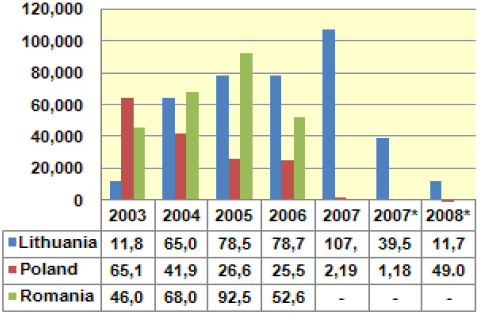



International Egg and Poultry Review
US - By the USDA's Agricultural Marketing Service - This is a weekly report looking at international developments concerning the poultry industry.The European Commission Submits Proposal to Allow Limited Use of Antimicrobial Treatment of Poultry
On May 28, 2008 the European Commission submitted a proposal to the Standing Committee on Food Chain and Animal Health that sets strict conditions on the use of four antimicrobials for use in processing poultry carcasses. This follows the March release by the European Food Safety Authority (EFSA) of a scientific opinion that says despite a long history of use, insufficient evidence exists to conclude that the application of the four PRTs to remove microbial contamination of poultry carcasses will lead to the occurrence of antimicrobial resistance. The proposal needs to be ratified or rejected by the Standing Committee on Food Chain and Animal Health (SCoFCAH).
If accepted, this would open the way for imports of poultry from the United States. U.S. poultry meat exports to the EU have been banned since April 1, 1997 because U.S. poultry producers currently use washes of low concentration pathogen reducing treatments (PRTs), such as chlorine, to reduce the level of pathogens in poultry meat production, a practice not permitted under the EU sanitary regime. In December 2005, the European Food Safety Authority (EFSA) completed studies of four PRTs and found them to be safe. In February 2006 the European Commission’s Health and Consumer Protection Directorate General circulated the first draft of a proposal to allow PRTs to be used on poultry meat in the EU market, but the draft regulation banned the simultaneous use on poultry products of more than one PRT and required poultry treated with PRTs to be rinsed after treatment. These two requirements would limit the ability of most U.S. producers to export poultry to the EU.
The Commission’s proposal set strict conditions for the use of antimicrobial treatment of poultry. The substances will have to be used separately and only on whole carcasses. The poultry carcass must be rinsed with potable water after treatment but before entering the chilling or refrigerating rooms. Any poultry processed in the manner would have to be labeled “treated with antimicrobial substances” or “decontaminated by chemicals.” The proposal also foresees that within 2 years from the date of application the authorization and the conditions of their use will be mandatorily reviewed.
Businesses using the antimicrobial substances would be required to collect data for research and monitoring purposes. The research will be on possible antimicrobial resistance at medium and long term, since no effect has been observed in short term use; the impact of the disposal of the waste water on the environment; the possibility of resistant strains developing in the waste water.
As a result of the proposal, a technical change must be made to the rules on the definitions and marketing standards for poultry meat. This separate proposal, to amend an existing Regulation, will be sent to the Council and European Parliament. If it is not adopted until after the entry into force of the Lisbon Treaty it would become an issue for co-decision between the Council and Parliament. (The Lisbon Treaty will define what the EU can and cannot do and what means it can use. The target date for ratification is January 1, 2009.)
Several groups, including the European Consumers’ Organization, the COPA-COGECA farming lobby, and the European Environmental Bureau, are against lifting the EU ban on U.S. poultry meat treated with antimicrobials. Some MEPs (Members of the European Parliament) in the Environment Committee have also raised concerns.
The European Union grew from 15 Member States in 1995 to 27 Member States in 2007
Source: Europa http://europa.eu Press Release; European Food Safety Authority; U.S. Trade Representative; news wires; The U.S. Mission to the EU; BEUC press release; CIA World Factbook
U.S. Poultry Meat Exports to Select Countries
H.S. code 0207 in metric tons

* Jan-Mar
Source: Department of Commerce, U.S. Census Bureau,
Foreign Trade Statistics
Export Requirements for Colombia (Processed Egg Products)
As of June 2, 2008 all egg products are eligible for export to Colombia. The required documentation can be found in the Export Requirements for Egg Products document in the Export Library.
Among the requirements:
- statements which say the product was derived from poultry which originated from a zone free of notifiable avian influenza and Newcastle disease as defined by the World Organization for Animal Health (OIE)
- egg products were derived from federally certified processing facilities operating under the permanent inspection of the Food Safety and Inspection Service (FSIS)
- microbiological tests on representative samples were conducted with negative results for Salmonella
- and the product is used without restriction in the USA and does not constitute risk to human and animal health.
http://www.fsis.usda.gov/regulations_&_policies/Colombia_Egg_Prod ucts_Requirements/index.asp
Source: FSIS/USDA
Further Reading
| - | You can view the full report by clicking here. |











